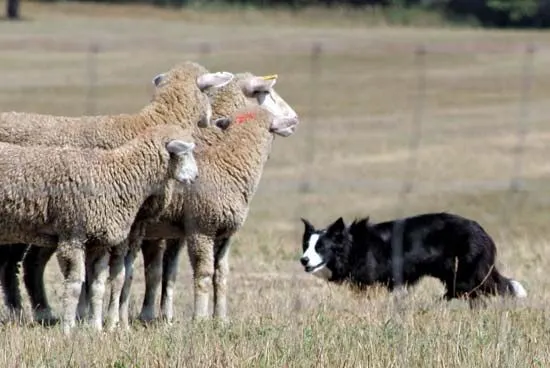At sheepdog trials, which I’ve written about before, there is a challenge called the Double Lift. The trials test shepherd and sheepdog to run a herd of sheep through a course and into a pen. The Double Lift is the challenge for champions that requires two groups of ten sheep be acquired from different parts of the (many-acre) field, collected together, and marched through gates on a predefined course, following which 5 marked sheep are separated from the group of 20 and then penned. It’s pretty impressive when accomplished by one shepherd and one border collie.

Complex Transformation is Universal
I have previously paralleled the sheepdog trial to the implementation of a transformation or change. The players are the shepherd, dog, and sheep—equivalent to the leader, change manager (and implementation team), and the organization’s personnel or stakeholders. Responsibility rests squarely on the shepherd’s shoulders and the dog does most of the work.1[1] I note that the objective and plan are known in advance in both cases, thus pointing to the criticality of tactical execution.
Within the tactical execution of getting sheep from start to successful finish, a number of learnings relevant to an organizational transformation or change jump out. Let’s consider them.
Lessons from the Double Lift
Lesson 1: Get and keep them together.
It is impossible to move sheep through a course unless they are all together. Thus the first order of business and an ongoing obligation is to get and keep them together. For sheep, this means physical proximity. In a transformation, it more appropriately means together mentally—understanding and thinking in the same general way.
Lesson 2: Inertia has rewards.
Keep them moving; but not too fast. It seems easier to shape the direction the herd moves than it is to get them moving. So, best to keep them moving. (Sailors understand this as keeping water flowing over the rudder.) A delicate touch is needed to not get the herd moving too fast because an out-of-control stampede has unpredictable energy and logic.
Lesson 3: Larger groups can be easier to manoeuvre than small ones.
Often, once they’re moving, larger groups can be finessed more readily than small groups. It’s the herd mentality, otherwise known as level of social feedback. A small group of loosely connected individuals will not generate the social feedback resonance to incent the undecided to move, whereas in a larger group it may take only a “first mover” or two to energize the entire group. Each subsequent choice to follow increases internal pressure on the remainder of the group.
Lesson 4: Constant, firm pressure is essential.
Too much pressure and the individual sheep resist directly (react, rebel, etc.) OR they may collectively stampede/cluster more tightly. The dog is always pressing the herd—even by its mere presence. There is never a time when pressure is off the herd until the objective is reached. To get the herd to act, it must gently raise the pressure. Things go awry when the pressure is too great: perhaps the dog moves too fast or gets too close. Things also go awry when pressure is relieved.
Lesson 5: Patience is crucial.
Sometimes during a shed, the part of the Double Lift when five marked sheep are separated from the full herd of twenty, the shepherd/dog team may spend a lot of time on just a few or even one troublesome sheep—over and over. Shepherd and dog must work together, calmly and persistently, to extract that particular sheep. The reward may be small—that one sheep shed, or it may be significant with other targeted sheep moving off with it. For either outcome: persistent, consistent pressure wins the day.
A sheep may aggressively resist, indicated by stomping its hooves while staring down the dog, momentarily. It’s short-lived if the dog is responding correctly with constant, patient pressure on the sheep. (Even under time pressure from the clock, the shepherd has to curb the dog’s enthusiasm at these moments.) The sheep rarely outlasts the dog, usually dodging back to the safety of the group or simply losing track of what it’s complaining about. Either way, patience (and not a lot of it) wins the day.
Lesson 6: There’s ALWAYS a Kevin.
I’ve seen a fair number of Double Lifts. In every one there is, at different times, a sheep that for whatever reason chooses to be belligerent and uncompliant: independent, if you will. I refer to it as Kevin.2 It is to be expected and why lessons 4 and 5, particularly, are important. This is consistent with my experience with organizations and transformation or change. Sometimes—not always—Kevin is just a little too clever for his own and certainly our good—at least as far as the change or transformation objective goes.
Conclusion
It may initially feel like a demeaning parallel—dogs and sheep in a field to humans in a complicated organizational activity. I hope this exposé has dispelled that appearance. Moreover, I hope the lessons translated from that context are now obvious in application to transformation and change initiatives in organizational settings.
How (you choose) to apply them is, however, for another day. Appreciating the timeless and contextless lessons is enough for now.
Institute X is a transformation leadership consultancy and leader coaching firm. One of its online presences is The Change Playbook. Check out the abundance of pragmatic guidance. Subscribe to be notified of new, fresh content.
- Or “Accountability” for RACI purists. ↩︎
- Gru, in Despicable Me, repeated, “Kevin…” Kevin McAllister stayed Home Alone because he had to do his own thing. This is just an echo, not intended to be an insult to Kevins generally. ↩︎
